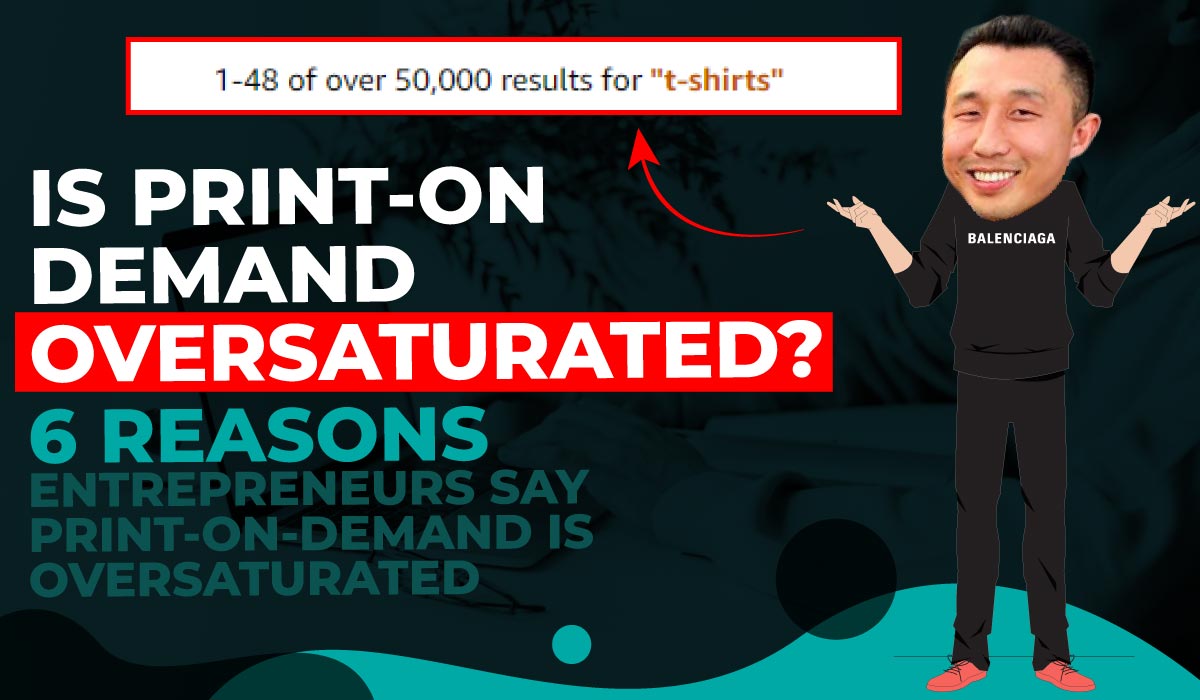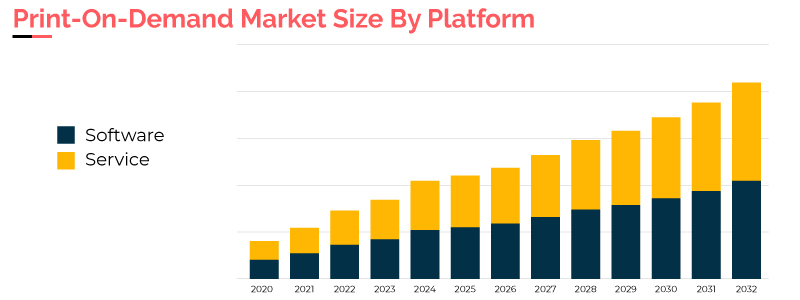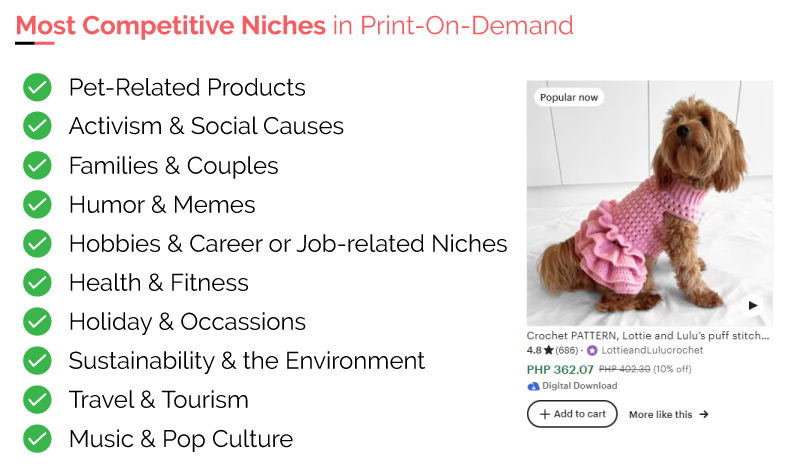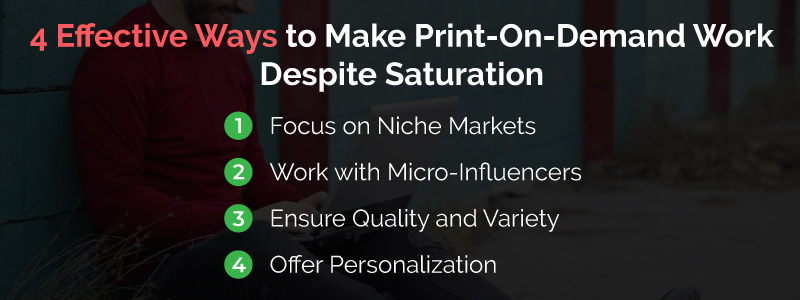
Print-on-demand is oversaturated in 2024. Evidence lies in the intense competition between entrepreneurs offering similar products for the same target consumers. This leads to consumer fatigue, high advertising costs, and low-quality products. For example, Printful is connected to over 149,000 e-commerce stores, with 70% or 104,301 stores originating from the United States.
Despite the oversaturation, people from Reddit, Quora, and YouTube still think that print-on-demand is not dead. According to Gelato, you can earn a profit of $4639 per month, while Printify said that you can make a 40%-50% profit margin. Printify also said it usually takes 165 days to hit their first $1000 revenue on average. Marketers said that to succeed in POD, you need to focus on targeted niches, work with micro-influencers, and offer high-quality products, personalization, and customization.
In this article, we will explore the 6 reasons entrepreneurs believe it is oversaturated, the strategies to succeed, the people’s opinion on this market, and the factors behind its continued popularity. Lastly, I will share an alternative business model that is comparable to POD in terms of initial cost.
6 Reasons Entrepreneurs Say Print-On-Demand is Oversaturated

1. Print-On-Demand’s Intense Market Competition
Print-on-demand’s intense market competition is a sign that it is oversaturated. Over the years, print-on-demand has emerged as a popular business model that is continuously growing. However, as its popularity rise, so does the intensity of market competition, making it increasingly difficult to stand out.

Source: Statista
According to Statista and Store Leads, the number of POD businesses in the United States has grown over the years. Printful currently connects to 149,001 e-commerce stores, with 98% or 146,000 stores being on Shopify. From these numbers, 70% or 104,301 stores are from the United States. In addition, 42.2 % or 62, 878 of these stores sell apparel.
Printify has a connection to 79,065 e-commerce stores, with 97.9% or 77,404 stores being on Shopify. Of these, 75.1% or 59,377 stores are in the United States. Similar to Printful, the top product comes from apparel products with 44.3% or 35, 265 stores. According to Similar Web, Printify has over 6.6 million monthly visits while Printful has 4.4 million.
2. Print-On-Demand’s Product Redundancy
Print-on-demand product redundancy means that entrepreneurs offer similar products that overlap in design, style, and functionality. This is because it is easy to get into POD and there are print-on-demand platforms and tools available to help you create and sell products quickly. For instance, searching the word “t-shirt” on Amazon gives over 50,000 results.

Product redundancy leads to a loss of sales. Many consumers will opt for products with lower prices or refrain from purchasing because they lack uniqueness. Tidio said that 45% of Gen Z, or 45 out of 100 customers, check out prices in different stores online to compare and get the best deal before purchasing. Redundancy makes it difficult for individual businesses to gain visibility and attract customers.
3. Print-On-Demand Leads To Consumer Fatigue
Print-on-demand oversaturation leads to consumer fatigue. This is because the market is saturated with similar product designs and advertisements with repetitive content and offerings. Without personalization and customization, consumers are likely to ignore similar products.
Moreover, consumers seek unique and meaningful products that align with their personal preferences and values. This means they gravitate towards brands and products that stand out by offering something different from the rest. As shown below, a simple search for the keyword “t-shirt” on Etsy results in 11,764 results with ads, and 2,240,000 search volume per month.

An Epsilon survey in 2017 found that 80% of the respondents aged 18-64 years old buy from a store that offers a personalized experience. In addition, Deloitte also found that 50% of consumers are interested in buying customized products. Forbes magazines mentioned that consumers are four to six times more likely to purchase from companies with a clear purpose. Last, Nielsen global survey said that 73% want products that are sustainable and help reduce their impact on the environment.
4. Print-On-Demand Struggles With Increased Advertising Costs
Print-on-demand struggles with increased advertising costs. This is fueled by digital marketing platforms like Facebook and Google. As more businesses enter the POD space using these advertising channels, the cost of ads has increased over the years. However, it is difficult to avoid these costs. According to Hubspot Blog Research, social media remains the #1 marketing channel that offers the highest return on investment (ROI).

According to WebFX, here are the advertising cost for some of the most popular digital advertising platforms:
ADVERTISING PLATFORMS
SMMA
- average cost per click (CPC) : $0.26 - $0.30
- average cost per 1000 impressions (CRM): $1.01 -$3.00
- average cost per like: $0.01- $0.24
- average cost per download: $0.01-$5.0
- average cost per click: $0.11-$0.50
- average cost per 1000 impressions: $0.51-$1.0
YouTube
- average cost per view or action: $0.11-$0.50
- average cost per click: $0.01 - $0.75
- average cost per 1000 impressions: $0.01 - $6.00
- average cost per engagement: $0.03 - $0.08
TikTok
- cost per view bid: $0.10-$0.30
- cost per 1000 impressions bid: $0.50-$10
- cost per click bid: $4-$8
TikTok Influencer Rate
- 1000-10,000 followers: $5-$25 per post
- 10,000-50,000 followers: $25-$200 per post
- 50,000-500,000 followers: $100-$1,000 per post
- 500,000-1,000,000 followers: $1000-$2000 per post
- 1,000,000+ followers: $2000+ per post
- average cost per follow for promoted accounts: $0.1–$4
- average cost per action for promoted Tweets: $0.26–$1.50
- average cost per click: $2.00–$4.00
- average cost per 1000 impressions: $3.01–$10.00
- average cost per send for Sponsored InMail campaigns: $0.26 - $0.50
In addition, WebFX also said that one average, small and mid-sized business typically spends from $2500-$12,000 per project. The saturation in the POD market brought changes in customer behavior, algorithms, and ad policies. The increased competition for ad space increases advertising costs.
5. Print-On-Demand Suffers From Low-Quality Concerns
Print-on-demand suffers from low-quality product concerns. Sellers have limited control over supply, production, printing, materials, color, durability, and packaging. Since products were created on demand, the results are inconsistent.
Furthermore, delivery delays can tarnish the reputation of your brand. For instance, BrightLocal found that 91% of the consumer said reviews affect their overall perceptions of the store or brand. Also, 88% will purchase from businesses that reply to all reviews and 77% use two or more sites to check business reviews.
6. Print-On-Demand’s High Competition in Popular Niche

Print-on-demand’s high competition in popular niches makes it difficult for beginners in POD to enter the space. However, there is still an enormous opportunity to earn from many consumers. Printify, Printful, and Gelato have identified the most competitive niches in the POD market this 2024, such as:
Also, Grand View Research said that the top print-on-demand products for 2023 are apparel, home decors, drink wares, accessories, and others. Also, Printful rated hoodies, sportswear, premium t-shirts, eco-friendly products, hats, stationery, wall art, phone cases, drink ware, and bags and the top trendy products of 2023.
4 Effective Ways To Make Print-On-Demand Work Despite Saturation

1. Focus on Niche Markets.
One of the effective ways to make print-on-demand work despite oversaturation is focusing on very specific niche markets. This is to reduce the number of direct competitors and ensure that your products and marketing efforts are more visible.
Another effective strategy is developing an interesting brand story, purpose, and aesthetic. Use social media to build a community around your brand and create a good online presence. Engage with your audience by sharing content, stories related to your niche, and customer testimonials. You may also partner with micro-influencers within your niche to reach a wider audience.
In the example below, searching for the keyword “t-shirt” gives 11,764 results and 2,240,000 search volume per month. But, if you make it more targeted like “t-shirt for teachers”, it only gives 74 targeted results and 4,400 search volume per month.

2. Work with Micro-Influencers.
Working with micro-influencers is another effective way to succeed in the print-on-demand space. This can increase your reach, improve brand authenticity, and drive consumer engagement. According to Hubspot Blog Research in 2023, 86% of marketers say that influencer marketing was effective for their company in 2023.
As per Sprout Social, micro-influencers are those with 10,000 to 100,000 followers. Statista revealed that nano and micro-influencers often boast higher engagement rates compared to big celebrities. This is because their followers trust them and perceive them as relatable and knowledgeable. As a result, the content shared by micro-influencers is more likely to be seen, interacted with, and acted upon by their audience.

In addition, collaborating with micro-influencers is more cost-effective. Shane Barker, an SEO and marketing expert, said that 82% of consumers are more likely to listen to a recommendation made by a micro-influencer. Influencer Marketing Hub found a strong preference among marketers to work with nano and micro-influencers (70%) than expensive macro-influencers and celebrities (30%). Moreover, Hubspot Blog Research also sees that micro-influencers have the most success in 2023.

Influencer Marketing Hub also shared how much it costs to engage with e-commerce influencers, such as with micro-influencers in 2024:
MICRO-INFLUENCER PLATFORMS
Instagram
YouTube
TikTok
X (Twitter)
ADVERTISING COSTS
$100-$500 per post
$200-$1000 per video
$25-$125 per post
$20-$100 per post
$250-$1250 per post
The price above varies depending on the type of partnership. It could be through shoutouts, giveaways, affiliate marketing, sponsored content, product or gift giving, brand ambassadorship.
3. Ensure Quality and Variety.
To make print-on-demand work despite the threat of oversaturation, you need to ensure that your product has the highest quality. PwC revealed that 73% of consumers think that the quality of the experience matters in their purchasing decisions. Providing high-quality products leads to a positive customer experience and higher satisfaction rates.
Adobe said that customers who rate a product as 'high quality' are more likely to remain loyal. In addition, providing a wide range of products can encourage customers to make repeat purchases. If customers know that they can consistently find new and interesting products, they are more likely to return. For instance, Amazon’s vast product selection is a key factor in its high customer retention rates.
To ensure the quality of your product, you must partner with reputable printing and fulfillment partners. Conduct regular quality inspections and provide clear and accurate product descriptions and images. If possible, offer options for customization of material quality or printing techniques.
Also, gather and act on customer feedback regarding product quality quickly. This involves adjusting designs, switching materials, or even changing POD partners if necessary. Last, highlight the quality of your products in your marketing efforts by using high-quality images. Share customer testimonials and provide detailed product descriptions to show the value of your offerings.
4. Offer Personalization.
Offering personalization is another powerful strategy to make print-on-demand work despite saturation. Personalization offers unique, tailor-made products that can enhance customer engagement and loyalty.
According to Epsilon, 80% of consumers are more likely to purchase a brand that offers personalized experiences. Similarly, Deloitte's research found that 1 in 5 consumers will pay 20% more for a personalized product. This means that personalized experiences can be a powerful tool in building customer loyalty. Furthermore, Hubspot Blog Research found that 94% of marketers say personalized experiences increase sales.

Source: HubSpot Blog Research, Marketing Trends Report
Offering customers the option to add names, initials, or messages to products can enhance your product's appeal. Providing tools that allow them to upload their designs or customize products can be a major selling point.
In the POD market, product personalization offers an opportunity to make your brand stand out in a crowded market. This allows you to meet consumer demands for unique and meaningful products and build stronger customer relationships.
Is Print-On-Demand Oversaturated on Reddit?
Yes, people from Reddit think that print-on-demand is oversaturated, however, there is still a potential to earn a profit from it. Some of the identified market drives for print-on-demand include:
- growing e-commerce industry
- customer’s desire for customization and personalization
- increased interest in gift giving of custom products
- continued advocacy for sustainable and eco-friendly products
- rapidly changing trends
- increasing purchase ability
- development of new printing technologies that prints more products
In a Reddit thread about POD being dead or oversaturated, Dancam4 said that based on his experience doing POD for a year, he has earned around $3510. He added that although it is not life-changing or passive; it is still enjoyable getting paid doing your hobby. Ordinary_Emuu, mentioned that she made $4000 in profit for almost a year but also thinks that it is not passive because you spent a lot of time learning SEO and evaluating ads.

While others are firm in saying that POD is not oversaturated, others have quite mixed opinions. Nimitz34 said that everything depends on where you are doing the business from. He mentioned that print-on-demand only earns "beer money" or little earnings. He added that print-on-demand is an already saturated market and most gurus will encourage buy their courses and tools.

SithLordJediMaster agreed that competition is everywhere, but also said that you just have to do it better while realSantanAMA added that if you will just do the same things as thousands of other people in the market, you will not make a lot of money. Another user, ChrisPRF, posited that POD will always be in demand, however since it is easy to set up and outsource, it has resulted in a significantly saturated market and a tough field to get in.

TheMrGenuis said that there’s a high chance to make a lot of money in Merch by Amazon (MBA) but it is difficult to get in. Mitsk2002 said that after selling on Redbubble for about 6 months and uploading 1 design per weekday, his earnings are still under $15. BulbasaurBoo123 shares that selecting a profitable niche and marketing is key to success.

In summary, while opinions on print-on-demand saturation vary, success lies in niche selection, marketing efforts, and differentiation. It remains a viable option for those willing to invest time and effort into understanding the market and adapting to its dynamics.
Is Print-On-Demand Dead?
No, print-on-demand is not dead. According to Straits Research, print-on-demand will reach $46.6 billion by 2031 globally, with a compound annual growth rate (CAGR) of 25.3 % from 2023 to 2031. This value is over 621% higher than its market value in 2022, which is $6.3 billion. In fact, according to Keywords Everywhere and Google Trends, the keyword print-on-demand has a growing global search volume of over 200,000 per month.


Search interest with other related keywords such as print-on-demand in Amazon, print-on-demand t-shirts, print-on-demand Etsy, print-on-demand websites, and print-on-demand books also get a high search volume.

According to Google Trends, for the past five years, North America dominated the market for print-on-demand. Based on the latest Print on Demand Market Report 2024-2032 from Impactful Insights, Europe, Asia Pacific, Latin America, and Middle East and Africa follows North America.

They also identified the key players in the market, such as Printify, Printful, and Gelato. In the same report, they also identified four reasons print-on-demand will continue to be in demand. This includes the rapid growth of the e-commerce market, projected to reach over $10.17 billion in 2024 and over $42.1 billion by 2030.
Additionally, the number of e-commerce market users is projected to reach 3.1 billion by 2028. This accounts for approximately 40% of the projected total population. Impactful Research said that sustainability advocates, personalization, and customization drive the POD market. ComCap states that 20% will pay up to 20% extra for personalized products, that is 1 out of every 5 customers. Statistia revealed that 27% have tried new products for sustainability reasons and around 25% will spend more on sustainable fashion.
Moreover, to reduce production time and cost, entrepreneurs are printing at home. In a Reddit discussion, U_Nomad_Bro, who has been in the business for over 4 years, said that print-on-demand is not dead. He added that you need to spend at least two years of work before it earns passively. He spends 15 hours per week on average and earns enough to pay all his bills and then some for saving, investing, and other spending. FoxPiano, who sells shirts/sweatshirts, achieved similar results by making $300-$600 per day after a year. Another Redditor, dami3nfu, said that oversaturation has been on for years. Users spankmeuniversity, diubler82, and JacobStyle believe that it is not dead, but oversaturated, with fierce competition.

In the same manner, HelloGoodbyeFriend said that POD isn’t dead if you focus on building a legit brand first and then use it as a tool to help manufacture and fulfill your products. TheSoloSuite said that the key to POD is making unique and personalized designs.

According to Greg Gottfried, who has been in the print and demand industry for over 7 years, print-on-demand is not dead and is still worth it, even for beginners. However, in starting a print-on-demand business, there’s more competition, but there are also tens of thousands of niches that are pretty untouched. He recommended finding and making designs for these untouched small niches. Moreover, Greg also emphasized the advantages of using AI tools to make things easier and faster, especially if you are getting started.

Contrary to claims of print-on-demand (POD) being dead, there is evidence that the industry is thriving. In summary, the data and testimonials show that print-on-demand is far from dead. It presents opportunities for entrepreneurs willing to invest time, effort, and creativity. The industry's projected growth, success stories, and strategic advice suggest that print-on-demand remains a profitable venture.
Is Print-On-Demand Profitable in 2024?
Yes, print-on-demand is still profitable in 22024. However, you need to consider various factors such as market trends, competition, product quality, marketing strategies, and your ability to adapt to the demands of the business. According to Gelato, you can earn a profit of $4639 per month, which can be as low as $1583 and can go as high as $9833 per month. According to Printify, sellers usually take 165 days to hit their first $1000 on average while some reach $1000 in less than 118 days.
In a Reddit discussion, HappyBatling said that POD can still be profitable if you are selling something unique and targeting profitable niche markets. U_Nomad_Bro seconded this and said that he made $13,000 net for a 3-month-old design. However, he added that it involved tons of work, such as driving traffic, market research, fulfillment, and customer service.
Pure_Beginning also said that he does well with print-on-demand, with a consistent earning of over $1000 per month. He did it by marketing products to specific niches, persons, events, or holidays, using optimized keywords in your title, descriptions, and tags, avoiding populated markets, and finding less saturated markets.


According to SimilarWeb, Printify, one of the leading print-on-demand platforms that handles the printing of over 800 custom products, has a total monthly visit of 7.5 million in 2023. This drives an annual revenue of $10-15 million. Similar websites like Printful and Gelato have an average monthly visit of 4.6M and 1.6M, respectively. Printify alone said that their mid-to-high volume sellers make 40%-50% profit margin of their products. In addition, 24% of print-on-demand shops are still up and running after three years.
Print-On-Demand Market Saturation VS Other Business Models
The print-on-demand market has experienced rapid growth over the years. Precedence Research projects that it will reach $10.17 billion in 2024. Like any growing market, POD has become saturated. Here’s the comparison of the market saturation of POD with other popular e-commerce business models.
Business Model
Number of Sellers Involved
Market Demand
Competition Intensity
Print-On-Demand
High
(Thousands of sellers worldwide)
High
(Growing consumer interest in personalized and custom products)
High
(Low barrier to entry results in a crowded marketplace)
Dropshipping
Very High
(One of the most popular e-commerce models because of its low startup costs and ease of entry)
Medium
(Depends on the niche and products chosen)
Very High
(Intense competition, particularly for generic products that are widely available)
Online POD Marketplace (Etsy)
High
(Etsy reported over 7.47 million active sellers)
High
(Steady demand for unique, handmade, and personalized items, with a loyal customer base looking for craft and artisan products)
Medium to High
(Competition depends on the niche and uniqueness of products)
Amazon FBA
High
(Hundreds of thousands of sellers use FBA for logistics support. Amazon has has 9.7 million)
Very High
(Amazon has a massive customer base with high demand across almost all product categories)
Very High
Intense competition because of the vast number of sellers and products.
3 Major Factors Why People Still Want To Do Print-On-Demand
1. Print-On-Demand Offers Low Initial Investment and Risk
Print-on-demand offers low initial investment and risk. You only need to set up an online storefront for your designs such as in Amazon Merch by Demand, eBay, Shopify, or Etsy, which usually have minimal or no cost. Print-on-demand technology providers, like Printify and Printful, are integrated into these marketplaces. By having POD providers handle the printing, packaging, and shipping, you also lower your operational costs.
In POD, there is no overstocking or financial risk involved because the system only creates products when there is a demand. You can also make as many designs as possible with no additional monetary cost.
Moreover, trends also change rapidly, and what's popular today may not be tomorrow. You can adapt to these changes by updating your designs or products without worrying about past inventories. Also, scaling up is much easier with print-on-demand. You can begin with limited products and expand as your business grows, with less investment or risk.
Is Print-On-Demand Free?
No, print-on-demand is not entirely free, but the cost to start is lower. You can save more if you use free tools while starting. Creating accounts on most e-commerce platforms is mostly free. But, you have to pay a transaction or subscription fee when using their services. You have the option to charge the customer for shipping of the products or add it to the product price.
To attract customers, you need to invest in marketing and advertising, such as social media ads, Google Ads, SEO optimization, and more. If you want to have your website for your store, you may need to pay a certain amount for domain and hosting services.
2. Print-On-Demand Provides Flexibility and Creative Control
Print-on-demand provides you with flexibility and creative control. This enables you to offer a wide range of products without worrying about inventory or financial risks. This allows you to change your product line easily according to market trends, customer feedback, or preferences. There is no limit to your creativity and you adjust your designs at any time.
As a seller, you can focus on design, marketing, and building customer relationships. Your POD partners will handle the logistics of production and fulfillment. This minimizes financial risk, maximizes your creative expression, and grows your business.
3. Print-on-demand Allows Automation and Ease of Operation
Print-on-demand allows automation and ease of operation to streamline the process, minimize manual tasks, and lower financial risk. Major e-commerce platforms like Shopify, WooCommerce, and Etsy integrate with POD services, automating the transfer of order details. As soon as there is an order, the system prints, packs, and ships the products.
One of the most challenging aspects of running an e-commerce business is managing inventory and fulfillment. POD services eliminate the need for physical inventory, so you don’t have to worry about storage space, stock levels, or unsold goods.
With POD, you can often automate adding new products or updating existing ones. Therefore, when you create a new design or want to offer a new product type, you can easily upload the design and select the products you want to sell. The system auto-generates product images, descriptions, and variants, saving time and effort.
While customer service remains a hands-on aspect of any business, POD can reduce the workload in this area, too. The providers often address issues directly, reducing the need for business owners to manage them.
Why the Local Lead Gen Biz Model is Another Option for a Print-On-Demand Business?
The local lead generation business model is another option for print-on-demand because it also requires low initial investment and entry requirements. According to Merchize, you may start with POD for free or subscribe to suppliers offering paid plans ($9 to $49 per month). If you create your website, you pay for a domain name ($8 to $20 per month) and website hosting ($8-$65 per month). You may also use an e-commerce platform ($17- $300 per month) and a reputable payment gateway that usually charges 2.4%-4.9% per transaction.
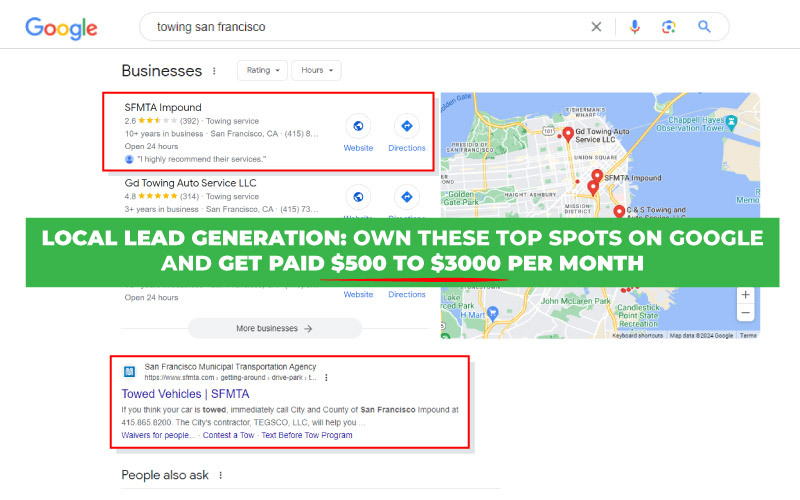
The POD market is highly competitive in popular niches, so building a successful brand is crucial to stand out. In local lead generation, competition still exists, but it is less intense than in global print-on-demand markets. With effective SEO and content marketing strategy, it is easier to stand out. In POD, you earn when someone buys your product. With local lead generation, you can ask for a monthly flat rate fee of $500-$3000. The initial cost for local lead generation is between $500-$1000. Once your site is ranked and generating leads, the ongoing costs are relatively low.
Social Media Today said that 46% of all Google searches are looking for local information and 97% of search engine users are looking for local businesses. From the same research, 72% of consumers who search for local businesses end up visiting stores within a five-mile radius. From the local mobile searches, 78% result in an in-store purchase. These statistics highlight the huge potential of an optimized local lead gen site to drive customers.
Both business models can offer success in the digital space. But if you’re looking for a business with lower competition and a high return on investment (ROI), local lead generation is the one to choose.




